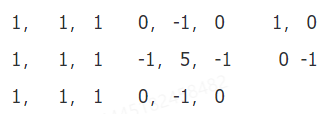OpenCv 030---Opencv中的自定义滤波器
1 前备知识
图像卷积最主要功能有图像模糊、锐化、梯度边缘等,前面已经分享图像卷积模糊的相关知识点,OpenCV除了支持上述的卷积模糊(均值与边缘保留)还支持自定义卷积核,实现自定义的滤波操作。自定义卷积核常见的主要是均值、锐化、梯度等算子。下面的三个自定义卷积核分别可以实现卷积的均值模糊、锐化、梯度功能。

2 所用到的主要OpenCv API
/** @brief Convolves an image with the kernel. @param src input image. @param dst output image of the same size and the same number of channels as src. @param ddepth desired depth of the destination image, see @ref filter_depths "combinations" @param kernel convolution kernel (or rather a correlation kernel), a single-channel floating point matrix; if you want to apply different kernels to different channels, split the image into separate color planes using split and process them individually. @param anchor anchor of the kernel that indicates the relative position of a filtered point within the kernel; the anchor should lie within the kernel; default value (-1,-1) means that the anchor is at the kernel center. @param delta optional value added to the filtered pixels before storing them in dst. @param borderType pixel extrapolation method, see #BorderTypes @sa sepFilter2D, dft, matchTemplate */ CV_EXPORTS_W void filter2D( InputArray src, OutputArray dst, int ddepth, InputArray kernel, Point anchor = Point(-1,-1), double delta = 0, int borderType = BORDER_DEFAULT );
/** @brief Scales, calculates absolute values, and converts the result to 8-bit. @endcode @param src input array. @param dst output array. @param alpha optional scale factor. @param beta optional delta added to the scaled values. @sa Mat::convertTo, cv::abs(const Mat&) */ CV_EXPORTS_W void convertScaleAbs(InputArray src, OutputArray dst, double alpha = 1, double beta = 0);
3 程序代码
#include <opencv2/opencv.hpp> #include <iostream> using namespace cv; using namespace std; int main(int artc, char** argv) { Mat src = imread("images/test.png"); if (src.empty()) { printf("could not load image...\n"); return -1; } namedWindow("input", CV_WINDOW_AUTOSIZE); imshow("input", src); Mat kernel1 = Mat::ones(5, 5, CV_32F) / (float)(25); Mat kernel2 = (Mat_<char>(3, 3) << 0, -1, 0, -1, 5, -1, 0, -1, 0); Mat kernel3 = (Mat_<int>(2, 2) << 1, 0, 0, -1); Mat dst1, dst2, dst3; filter2D(src, dst1, -1, kernel1); filter2D(src, dst2, -1, kernel2); filter2D(src, dst3, CV_32F, kernel3); convertScaleAbs(dst3, dst3); imshow("blur=5x5", dst1); imshow("shape=3x3", dst2); imshow("gradient=2x2", dst3); waitKey(0); return 0; }
4 运行结果
5 扩展及注意事项
6*目前只做大概了解,知道有这一算法,后续具体使用再做具体分析
One day,I will say
"I did it"



